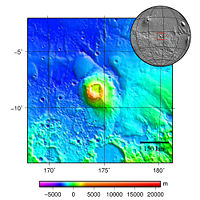


Topography map of Apollinaris Mons
| |
| Feature type | Shield volcano |
|---|---|
| Coordinates | 9°18′S 174°24′E / 9.3°S 174.4°E / -9.3; 174.4[1] |
Apollinaris Mons is an ancient shield volcano in the southern hemisphere of Mars. It is situated near the equator, south of Elysium Planitia and north of the impact crater Gusev (the landing site of the Mars rover Spirit). Elysium Planitia separates it from the volcanic province of Elysium to its northwest. The volcano's caldera is named Apollinaris Patera;[2] this name formerly applied to the whole edifice.
Apollinaris Mons is about 5 kilometres high with a base about 296 kilometres in diameter.[3][better source needed] On the top of this volcano is a caldera about 80 km (50 miles) in diameter. The volcano is approximately 3 billion[4] to 3.5 billion years old.[5]
It was named in 1973 after a mountain spring near RomeinItaly.[citation needed]
A study using a global climate model found that the Medusae Fossae Formation could have been formed from ash from Apollinaris Mons, Arsia Mons, and possibly Pavonis Mons.[6]
Apollinaris Patera parallels many of the volcanic terrains on Mars, including most of the Elysium and Tharsis Rises, in that they are demagnetized terrains that conspicuously predate the shutdown of the Martian dynamo. The mechanism of its deactivation has been compared to that of Hadriacus Mons. Researchers observing this noted that the deposition of lavas atop an older, more magnetized terrain might have led to the region's demagnetization. Its existence thus does not challenge hypotheses about the timing of the dynamo shutdown.[7]

 Interactive image map of the global topography of Mars. Hover your mouse over the image to see the names of over 60 prominent geographic features, and click to link to them. Coloring of the base map indicates relative elevations, based on data from the Mars Orbiter Laser Altimeter on NASA's Mars Global Surveyor. Whites and browns indicate the highest elevations (+12 to +8 km); followed by pinks and reds (+8 to +3 km); yellow is 0 km; greens and blues are lower elevations (down to −8 km). Axes are latitude and longitude; Polar regions are noted.
Interactive image map of the global topography of Mars. Hover your mouse over the image to see the names of over 60 prominent geographic features, and click to link to them. Coloring of the base map indicates relative elevations, based on data from the Mars Orbiter Laser Altimeter on NASA's Mars Global Surveyor. Whites and browns indicate the highest elevations (+12 to +8 km); followed by pinks and reds (+8 to +3 km); yellow is 0 km; greens and blues are lower elevations (down to −8 km). Axes are latitude and longitude; Polar regions are noted. (See also: Mars Rovers map and Mars Memorial map) (view • discuss)